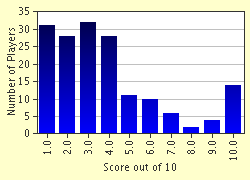Quiz Answer Key and Fun Facts
1. You find yourself in England in the Late Triassic period (215 million years ago). Ambling past you is a long necked dinosaur - it's not very large, about 2 metres long. It's walking on four legs, and you notice its back legs are longer than its front legs - it could probably rear up if it so desired. Attached to its arms are five fingered hands with large claws on the thumbs - maybe you should keep your distance. What is this dinosaur?
2. You move into the Late Jurassic period (160 million years ago), in France. Taking a rest by a lake, you find yourself being joined by a lumbering four-legged dinosaur, about 5 metres long. Instantly noticeable are the tall thin plates running down its back, as well as spikes jutting out of its shoulders, and on its tail. This dino seems pretty well defended, but what exactly is it?
3. Arriving in Argentina in the Early Cretaceous period (130 million years ago), you come across a group of long necked dinosaurs. One of them stops to take a bite of some leaves, and you notice peg shaped teeth in its mouth. As they walk past, you can clearly see that each one has two rows of long spines running along its neck, back and tail. What are these dinosaurs?
4. It's still the Early Cretaceous (120 million years ago), but you're back in England. You're a little worried when you spot a large carnivorous dinosaur, but it's not paying attention to you - it's focussed on the river, crouching down on all fours. You watch with interest as it swings one arm down into the river, and uses the large hooked claw on its hand to drag out a fish, before grabbing its victim in its crocodile like jaws. What is the name of this prehistoric fisherman?
5. Your next dinosaur encounter is in Utah, USA, in the Early Cretaceous period (120 million years ago). Ahead of you is one of the weirdest dinosaurs you've yet seen. Its body looks like a theropod, and it has a long neck and small head, but when it opens its mouth, you can see leaf shaped teeth more reminsicent of a herbivore! On the other hand, the same cannot be said for the large sickle shaped claws on its hands. And to top it off, it's covered in feathers! What could this curious creature be?
6. Your next encounter is a scary one - wandering through Niger in Africa in the Mid Cretaceous period (100 million years ago), you find yourself facing a colossal predator, about 13 metres from nose to tail! You run away before it notices you, but not before taking into account its large skull, with shark like teeth about eight inches long! What was that beast?
7. Looking for some more pleasant dinosaurs, you come to Montana, USA, in the Late Cretaceous period (75 million years ago). The dinosaurs you find aren't exactly hard to miss - the adults are about 9 metres long, and there's at least a hundred of them! They're walking on four legs, but some are comfortably rearing up on their hind legs to strip leaves from the trees. Each one has a duck like beak, and a small crest in front of its eyes. What are these dinos?
8. Having come to Canada in the Late Cretaceous period (75 million years ago), you are greeted by the sight of two dinosaurs in front of you. Fortunately, they are focussed on each other, waving their heads - their heads sport a dome on top, with bony knobs at the back. Close by are a few more of the same dinosaurs - they are feeding on the surrounding plants, even though they appear to have unusually sharp teeth for a herbivore. What dinosaurs are these?
9. You are wandering through a desert in Mongolia in the Late Cretaceous period (75 million years ago), when a two legged dinosaur walks past you. Looking at its short deep head, you can see it has a head crest, and a beak. It yawns, revealing two teeth at the top of its mouth. Your eyes turn to its hands, which appear to be designed for grasping. What dinosaur could this be?
10. Your last stop is in Colorado, USA, in the Late Cretaceous period (70 million years ago). A herd of herbivorous dinosaurs is browsing in front of you, walking on four legs. They clearly have very large heads, about 2.5 metres long! Much of that length is made up of a flat rectangular crest extending from the back of the head - as you get closer, you can just about see signs of two large holes in the crest, underneath the skin. One turns towards you, giving you a good view of the two long horns above its eyes, and the short one on its nose - maybe you shouldn't have gotten so close. What are these dinosaurs?
Source: Author
Velociraptor
This quiz was reviewed by FunTrivia editor
crisw before going online.
Any errors found in FunTrivia content are routinely corrected through our feedback system.

